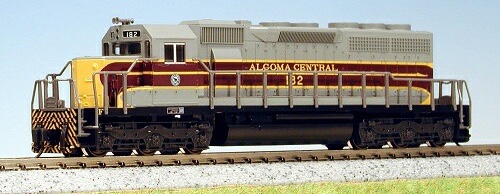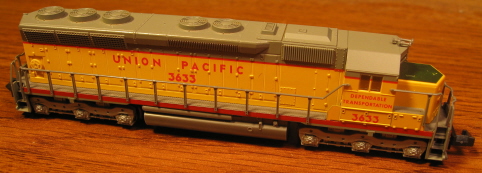| SD40 | SD45 |
 |  |
| SD40 | SD45 |
 |  |
Introduced: 1991 (SD40), 1995 (SD45), 2002 (Revised SD40), and 2010 (Revised SD45)
These models are all rungs on the same evolutionary ladder, so I'm going to save myself a bit of time and cover them all here.
Kato's 1991 SD40 was a ground-breaking model insofar as it was the first N-scale diesel to feature full pilots and shell-mounted couplers. The Micro-Trains friendly coupler-clip system instantly became something of an industry standard - copied by just about every other manufacturer to one degree or another.

In addition to the shell-mounted couplers, these models employ virtually all of the other time-honored design features one normally associates with "modern" Kato diesels - split-frame metal chassis, dual-flywheels, low-friction drive, plastic truck assemblies, plastic gearing, blackened wheels, all-wheel drive, and all-wheel pick-up (no traction tires). The motor is an open-sided 5-poler. Directional lighting is provided by PC boards mounted on either end of the chassis. The couplers are Rapidos (easily swapped out for MT's). Wheels are low-profile and have no problems on Code-55 track.
Kato released an SD45 model using this exact same chassis/mechanism in 1995 (with a second run in 1996). Oddly enough, it would be 15 years before Kato released any more SD45's. And I continue to remain mystified at Kato's propensity for creating awesome models, only to mothball them after a production run or two (U30C, C30-7, etc).
In 2002, Kato released a new run of SD40's. And although they employed the same basic mechanism design as the earlier SD40/45 models, the chassis was revised slightly in order to provide "DCC-Readiness" (IE, designed with a single lightboard that could be swapped out in favor of a "drop in" style decoder). And brother, this is one of the easiest decoder installation jobs you'll ever find in N scale (apart from removing the shell, no disassembly required). Additional improvements included white LED lights, printed numberboards, MU hose detail, magnetic knuckle couplers, and truck sideframes molded with high-mount or low-mount brake cylinders (as appropriate for the prototype) -

Shells from the old non-DCC SD40 (and SD45) models will fit on this new DCC-Ready chassis (and vice-versa).
As noted above, Kato (finally) released a new run of SD45 models in 2010 (employing the same DCC-Ready chassis as the 2002 SD40 models). Additional improvements include MU hose detail, snowplows, and Kato's magnetic knuckle couplers. The Great Northern version comes with a special railing-mounted logo plate to be installed by the modeler (Kato suggests using two-sided tape, of all things) -

Performance on all these models (regardless of version) is perfect in every way - smooth, quiet, flawless pickup and throttle response, exceptional pulling power, etc.
Removing the shell on all these models is very simple - take hold of the fuel tank with one hand and the shell with the other, then just sort of wiggle it up and off.
Prototype Information (SD45) -
Notable as the first locomotive with an engine larger than 16 cylinders upon its introduction in 1965, the EMD SD45 was used on nearly every railroad at one time or another. Over the course of six years, EMD built a whopping 1260 SD45 locomotives for freight use on more than 25 railroads, with many more acquiring them second-hand. The SD45, while sharing the same common frame as the EMD SD40, was distinguished by a number of characteristics such as the flared radiator that stretched across the side of the locomotive's long hood. Several SD45 locomotives are still preserved and in service today.
SPSF "Kodachrome": The Southern Pacific and Sante Fe railroads attempted to merge their companies in the 1980s; in anticipation, a number of locomotives were painted in a paint scheme that combined the SP red with Santa Fe's distinct "Warbonnet" decoration. The intention was for each locomotive to carry the "SPSF" logo, but before they could be completed the merger was denied by Interstate Commerce Commission. A fair number of locomotives remained in this paint scheme, carrying either the "SP" or "SF" designation to identify which railroad they belonged to. This particular paint scheme was nicknamed the "Kodachrome" scheme, due to its similarity to the distinct coloring of Kodak film of the same name.
Grade: A (all versions)
First-run SD40 reviewed: 3/91 Model Railroader ("The Kato SD40 models are nicely proportioned and are an exact match to prototype dimensions. Each unit is a scale 65'-0" long, 10'-6" wide, and 15'-6" high. This model is built in the same manner as its predecessors in the Kato line. It has an injection-molded plastic body with excellent fine detail... right down to the blades in the rooftop ventilating fans. The walkways and pilots are made up of two separate castings that snap into the body. A styrene casting contains the battery boxes, side sills, pilots, and steps, while the top surfaces of the walkways, stanchions, and railings are molded in a tough engineering plastic for durability.
"Mechanically, the model has a deceptively simple appearance as it has no unnecessary complication. The motor (with brass flywheels) and worm gears are clamped within a pair of heavy zinc-alloy weight castings that are insulated from each other so the model is divided electrically. The six-wheel trucks and their gear towers are also done in an engineering plastic, with most of the gearing and the electrical pickups enclosed within the truck. Both trucks are retained by the weights, and tiny contacts carry the electrical current to the motor. The coupler arrangement on these models is a nice departure from previous N scale diesels. These SD40 models come with body-mounted Rapido-type couplers and full pilot details. They don't have the usual wide gap in the pilot necessary to accommodate the coupler swing of truck-mounted couplers. This doesn't appear to be a problem for wide-radius mainline operation, but it may cause problems for modelers using tight-radius curves...
"Our samples ran smoothly and quietly throughout their speed range. The SD40s would start and continue running on only 1.8 volts. Unfortunately, the top speed is well above any normal train speeds, so most of the usable range will be in the lower third of the controller. The drawbar pull is equivalent to about 18 free-rolling cars on straight and level track. Overall, this is an excellent model that continues Kato's reputation for producing "state of the art" motive power. AT&SF, BN, CP, CS, C&NW, PRR, SP, UP. $82.95")
First-run SD45 reviewed: 9/95 Model Railroader ("A superb model of EMD's SD45 road switcher is Kato's newest entry in the N scale locomotive market... Kato's SD45 nicely captures the rugged good looks and proportions of its prototype. It closely follows prototype dimensions. Like most Kato road switchers, the SD45 features a highly detailed body made up of several styrene castings. The flexible handrails are molded as part of an engineering plastic walkway assembly that's cleverly sandwiched into recesses between the body parts. This neatly hides the thickness of the casting and provides walkways with a contrasting color. The cab has clear window glazing and it snaps onto the main body.
"Kato is well-known for its smooth-running diesels, and this model continues the firm's proven design. In fact, the shape of SD45's cast-metal weights is the only discernable difference I found compared to the C30-7... A pair of large zinc-alloy castings enclose the five-pole motor, dual flywheels, and worm gears. These castings are insulted from each other to provide a divided electrical path through the engine. Phospher bronze axle bearings, contact strips, and frame wipers transfer current from all the wheels to the motor through the frame. All the axles are driven through spur gears enclosed within the trucks. The flanges are a little oversized... Operation of the sample SD45 was nearly flawless, starting and running steadily on only 1.7 volts. The mid-range and maximum speeds match earlier Kato diesels so the SD45 will perform well with SD40s and GE six-axle units. Its 1.3-ounce drawbar pull is sufficient to haul about 31 free-rolling cars on straight and level track. The SD45 comes with Rapido-type couplers, but MT 1015s me be easily substituted... Our sample SD45 came neatly decorated in D&H colors. Its paint is even and the printing is clear and opaque. The chassis is unpainted dark gray plastic... Given the SD45's classis status, Kato has produced another winner for N scale modelers. Undec, ATSF, BN, Conrail, D&H, SP, UP, WC. $94.98")
Second-run SD45 reviewed: 5/11 Model Railroader ("This well-detailed N scale General Motors Electro-Motive Division SD45 is an upgraded version of a Kato USA model first released in 1996. This model�s all-new mechanism is easy to convert to Digital Command Control (DCC). Most of the Kato model�s dimensions match prototype drawings. The coupler shanks of the Kato couplers on the model are each one scale foot longer than the length shown in the drawing.
"The model has an illuminated headlight and front number boards. The molded detail, including access hatches along the long hood, on the N scale locomotive matches the prototype. Separately applied detail parts include a three-chime air horn, m.u. hoses on the pilots, and scale-profile handrails. The model�s paint matches prototype photos. The separation lines between all the colors are well-defined.
"The body shell is press fit, so it can be removed without tools. The motor and flywheels are encased by a split die-cast metal frame. A printed-circuit board with two light-emitting diodes for the headlights is on top of the frame. The headlights operate automatically according to the locomotive�s direction, which is unlike a prototype locomotive where the engineer must manually turn the headlights on or off. The number boards are set in illuminated boxes. Both Digitrax and Train Control Systems make board-replacement DCC decoders for this model. Price: $105")